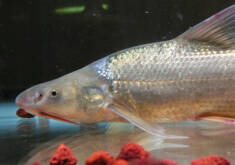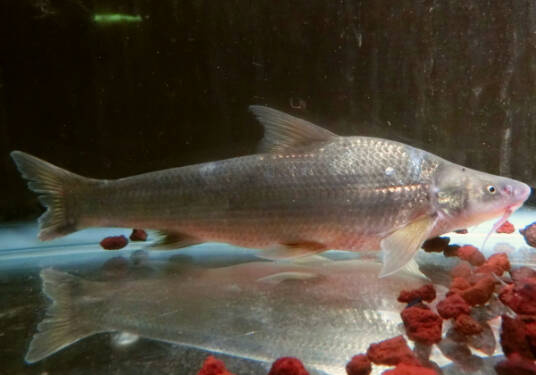
Alias Coreius guichenoti,Square head water nose, water nose, golden loach, net mouth, twist, fat Tuo, water dense, round mouth copper fish
Family Cypriniformes Cyprinidae Copperfish
Life No verification information
Coreius guichenoti, Latin name of round-mouthed copper fish, is a fish of Cyprinidae and genus Coreius.

Round-mouthed copper fish is an important economic fish in the upper reaches of the Yangtze River. Common individuals are mostly 0.5 to 1 kg, and the largest can reach 3.5 to 4 kg. The artificial domestication of round-mouthed copper fish has been successfully achieved at the Institute of Hydrobiology, Chinese Academy of Sciences, and artificial breeding has begun in some areas of Sichuan.
Round-mouthed copper fish are bottom-layer fish, living in rivers with fast currents, and often active in deep pools with many rocks and reefs. They have a mixed diet, feeding on aquatic insects, mollusks, plant fragments, fish eggs, and fish fry. Their feeding activities are closely related to water temperature. They feed strongly in spring and autumn, and weaken in winter. They feed both day and night, but the feeding rate during the day is lower than that at night.
Round-mouthed copper fish are sexually mature at 2-3 years old, and the spawning grounds are in Chongqing, Pingshan, Sichuan, in the upper reaches of the Yangtze River, and up to Duomei, Yunnan, on the Jinsha River. The reproductive season is generally from late April to early July, with a more concentrated period from May to early June. The egg-carrying capacity is 13,000 to 40,300. Drifting eggs are laid in the rapids with pebble bottoms. The eggs absorb water quickly and swell and develop and hatch in the process of drifting downstream. The diameter of the egg membrane is generally 5.1 to 7.8 mm, the perivitelline space is larger than that of domestic fish, and the egg membrane is thicker. When the water temperature is 22 to 24℃, the fertilized eggs can hatch after 50 to 55℃.
Due to the destruction of the spawning grounds, the round-mouthed copper fish lacks a supplementary population, and the resources of the round-mouthed copper fish are being caught less and less, and it has become an occasional species. Due to its own biological characteristics, the round-mouthed copper fish is difficult to domesticate, and research is still in the field of domestication and artificial breeding technology, and the protection pressure is very huge. Due to the limited resources of the round-mouthed copper fish, many basic research cannot be carried out. For example, the gonadal development and regulation technology of the round-mouthed copper fish, the invasion mechanism and prevention and control methods of the main disease of the round-mouthed copper fish, Ichthyophthirius spp., need to be further studied. Although the artificial breeding technology of round-mouthed copper fish has been broken through, the survival rate of its seedlings is extremely low. Only after the artificially bred fish seedlings are cultivated into broodstock and fully artificially bred can the species protection of round-mouthed copper fish be achieved.
Listed in the "List of Economic Aquatic Animals and Plants under State Key Protection in China (First Batch)".
Listed in the second level of the "List of Wild Animals under State Key Protection in China" (only for wild populations).
Protect wild animals and eliminate game.
Maintaining ecological balance is everyone's responsibility!